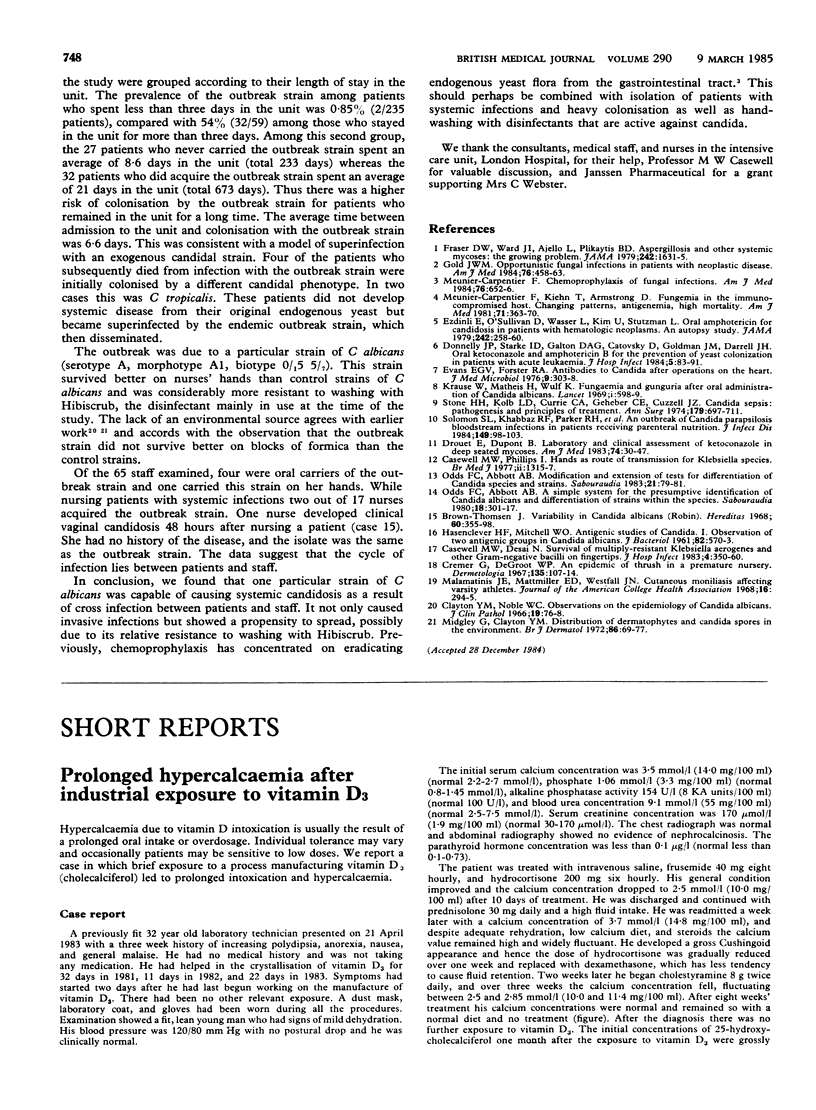Abstract
The first documented outbreak of systemic candidosis shown to be due to cross infection with a particular strain of Candida albicans is reported. Over nine months in an intensive care unit 13 patients developed definite and one probable systemic candidosis. Twenty five further patients had superficial candidal infections. The strain that caused the outbreak (serotype A, morphotype A1, biotype 0/(1)5 5/7) was responsible for all the cases of systemic candidosis acquired in the intensive care unit, 11 (44%) of the superficial candidal infections in the unit, and 17% of candidal infections outside the unit but in the same hospital. The strain was also isolated from oral swabs taken from four nurses working in the unit and the hands of one of these nurses. Two out of 17 nurses were shown to have acquired the strain on their hands when examined immediately after nursing systemically infected patients. No environmental source could be identified. The strain also showed enhanced survival in handwashing experiments and was relatively resistant to Hibiscrub. Management of patients with systemic candidosis might include measures to prevent cross infection and handwashing with disinfectants that are active against candida.
Full text
PDF


Selected References
These references are in PubMed. This may not be the complete list of references from this article.
- Casewell M. W., Desai N. Survival of multiply-resistant Klebsiella aerogenes and other gram-negative bacilli on finger-tips. J Hosp Infect. 1983 Dec;4(4):350–360. doi: 10.1016/0195-6701(83)90005-1. [DOI] [PubMed] [Google Scholar]
- Casewell M., Phillips I. Hands as route of transmission for Klebsiella species. Br Med J. 1977 Nov 19;2(6098):1315–1317. doi: 10.1136/bmj.2.6098.1315. [DOI] [PMC free article] [PubMed] [Google Scholar]
- Clayton Y. M., Noble W. C. Observations on the epidemiology of Candida albicans. J Clin Pathol. 1966 Jan;19(1):76–78. doi: 10.1136/jcp.19.1.76. [DOI] [PMC free article] [PubMed] [Google Scholar]
- Cremer G., de Groot W. P. An epidemic of thrush in a premature nursery. Dermatologica. 1967;135(1):107–114. doi: 10.1159/000254169. [DOI] [PubMed] [Google Scholar]
- Donnelly J. P., Starke I. D., Galton D. A., Catovsky D., Goldman J. M., Darrell J. H. Oral ketoconazole and amphotericin B for the prevention of yeast colonization in patients with acute leukaemia. J Hosp Infect. 1984 Mar;5(1):83–91. doi: 10.1016/0195-6701(84)90105-1. [DOI] [PubMed] [Google Scholar]
- Drouhet E., Dupont B. Laboratory and clinical assessment of ketoconazole in deep-seated mycoses. Am J Med. 1983 Jan 24;74(1B):30–47. doi: 10.1016/0002-9343(83)90512-0. [DOI] [PubMed] [Google Scholar]
- Evans E. G., Forster R. A. Antibodies to Candida after operations on the heart. J Med Microbiol. 1976 Aug;9(3):303–308. doi: 10.1099/00222615-9-3-303. [DOI] [PubMed] [Google Scholar]
- Ezdinli E. Z., O'Sullivan D. D., Wasser L. P., Kim U., Stutzman L. Oral amphotericin for candidiasis in patients with hematologic neoplasms. An autopsy study. JAMA. 1979 Jul 20;242(3):258–260. [PubMed] [Google Scholar]
- Fraser D. W., Ward J. I., Ajello L., Plikaytis B. D. Aspergillosis and other systemic mycoses. The growing problem. JAMA. 1979 Oct 12;242(15):1631–1635. [PubMed] [Google Scholar]
- Gold J. W. Opportunistic fungal infections in patients with neoplastic disease. Am J Med. 1984 Mar;76(3):458–463. doi: 10.1016/0002-9343(84)90665-x. [DOI] [PubMed] [Google Scholar]
- HASENCLEVER H. F., MITCHELL W. O. Antigenic studies of Candida. I. Observation of two antigenic groups in Candida albicans. J Bacteriol. 1961 Oct;82:570–573. doi: 10.1128/jb.82.4.570-573.1961. [DOI] [PMC free article] [PubMed] [Google Scholar]
- Krause W., Matheis H., Wulf K. Fungaemia and funguria after oral administration of Candida albicans. Lancet. 1969 Mar 22;1(7595):598–599. doi: 10.1016/s0140-6736(69)91534-7. [DOI] [PubMed] [Google Scholar]
- Malamatinis J. E., Mattmiller E. D., Westfall J. N. Cutaneous moniliasis affecting varsity athletes. J Am Coll Health Assoc. 1968 Feb;16(3):294–295. [PubMed] [Google Scholar]
- Meunier-Carpentier F., Kiehn T. E., Armstrong D. Fungemia in the immunocompromised host. Changing patterns, antigenemia, high mortality. Am J Med. 1981 Sep;71(3):363–370. doi: 10.1016/0002-9343(81)90162-5. [DOI] [PubMed] [Google Scholar]
- Meunier-Carpentier F. Symposium on infectious complications of neoplastic disease (Part II). Chemoprophylaxis of fungal infections. Am J Med. 1984 Apr;76(4):652–656. doi: 10.1016/0002-9343(84)90290-0. [DOI] [PubMed] [Google Scholar]
- Odds F. C., Abbott A. B. A simple system for the presumptive identification of Candida albicans and differentiation of strains within the species. Sabouraudia. 1980 Dec;18(4):301–317. [PubMed] [Google Scholar]
- Odds F. C., Abbott A. B. Modification and extension of tests for differentiation of Candida species and strains. Sabouraudia. 1983 Mar;21(1):79–81. doi: 10.1080/00362178385380111. [DOI] [PubMed] [Google Scholar]
- Stone H. H., Kolb L. D., Currie C. A., Geheber C. E., Cuzzell J. Z. Candida sepsis: pathogenesis and principles of treatments. Ann Surg. 1974 May;179(5):697–711. doi: 10.1097/00000658-197405000-00024. [DOI] [PMC free article] [PubMed] [Google Scholar]


